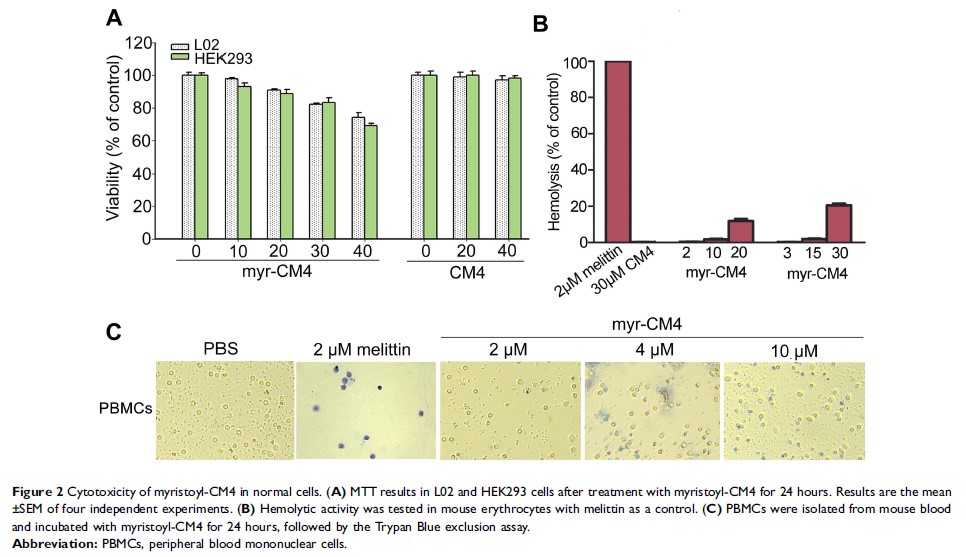9 0 8 1 0
论文已发表
注册即可获取德孚的最新动态
IF 收录期刊
- 2.6 Breast Cancer (Dove Med Press)
- 3.9 Clin Epidemiol
- 3.3 Cancer Manag Res
- 3.9 Infect Drug Resist
- 3.6 Clin Interv Aging
- 4.8 Drug Des Dev Ther
- 2.8 Int J Chronic Obstr
- 8.0 Int J Nanomed
- 2.3 Int J Women's Health
- 3.2 Neuropsych Dis Treat
- 4.0 OncoTargets Ther
- 2.2 Patient Prefer Adher
- 2.8 Ther Clin Risk Manag
- 2.7 J Pain Res
- 3.3 Diabet Metab Synd Ob
- 4.3 Psychol Res Behav Ma
- 3.4 Nat Sci Sleep
- 1.9 Pharmgenomics Pers Med
- 3.5 Risk Manag Healthc Policy
- 4.5 J Inflamm Res
- 2.3 Int J Gen Med
- 4.1 J Hepatocell Carcinoma
- 3.2 J Asthma Allergy
- 2.3 Clin Cosmet Investig Dermatol
- 3.3 J Multidiscip Healthc

新型肽 myristoly-CM4 通过坏死及/或凋亡途径在白血病 K562/MDR 和 Jurkat 细胞中诱导选择性的细胞毒性
Authors Zhang H, Han D, Lv T, Liu K, Yang Y, Xu X, Chen Y
Received 1 March 2019
Accepted for publication 9 May 2019
Published 2 July 2019 Volume 2019:13 Pages 2153—2167
DOI https://doi.org/10.2147/DDDT.S207224
Checked for plagiarism Yes
Review by Single-blind
Peer reviewers approved by Dr Colin Mak
Peer reviewer comments 2
Editor who approved publication: Dr Anastasios Lymperopoulos
Purpose: There is an urgent need for the development of novel, effective, and less toxic drugs to treat leukemia. Antimicrobial peptides (AMPs) have received much more attention as alternative chemotherapeutic agents. This study aimed to examined the cytotoxicity of a novel AMP myristoly-CM4 against chronic myeloid leukemia cells (K562/MDR) and acute lymphocytic leukemia cells (Jurkat), and further investigated its selectivity to clarify the cytotoxic mechanism.
Materials and methods: In this study, the cytotoxicity and selectivity of myristoly-CM4 against K562/MDR and Jurkat cells were assessed in vitro, and the anticancer mechanism responsible for its cytotoxicity and selectivity was further investigated.
Results: Myristoly-CM4 was cytotoxic to these leukemia cell lines (IC50 2–4 μM) and was less cytotoxic to normal cells (HEK-293, L02 cells, peripheral blood mononuclear cells, and erythrocytes). Myristoyl-CM4 had stronger affinity to K562/MDR and Jurkat cells than to normal cells, while the contents of phosphatidylserine and sialic acids on the cell surfaces of K562/MDR and Jurkat cells were significantly higher than that of HEK293 cells. The myristoyl group effectively mediated the internalization of myristoyl-CM4 to leukemia cells. After internalization, myristoyl-CM4 could target mitochondria and affected mitochondrial function, including disruption of Δψm, increasing the accumulation of ROS, increasing the Bax/Bcl-2 ratio, activating caspase 9 and 3, and PARP to induce mitochondria-dependent apoptosis in both K562/MDR and Jurkat cells. Myristoyl-CM4 also induced K562/MDR cell necrosis by directive membrane disruption, and significantly decreased the level of P-glycoprotein in K562/MDR cells.
Conclusion: These results suggested that myristoyl-CM4 showed selective cytotoxicity to leukemia K562/MDR and Jurkat cells by apoptosis and/or necrosis pathway. Myristoyl-CM4, thus, appears to be a promising candidate for leukemia treatment, including multidrug-resistant leukemia.
Keywords: leukemia, multi-drug resistance, necrosis, apoptosis, myristoyl-CM4, selectivity
